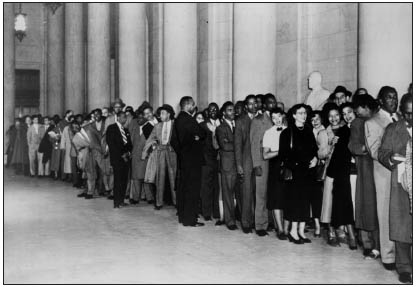
AT 1:00 a.m. on December 7, 1953, Arthur J. Smith, an elderly black man, stood first on line at the front door of the Supreme Court. At 2:00 a.m., a Howard law student joined him. By daybreak Reverend DeLaine of South Carolina, the organizer of Briggs v. Elliott, showed up. He told a reporter for the Baltimore Afro-American, “There were times when I thought I would go out of my mind because of this case. . . . I feel it was worth it. I have a feeling that the Supreme Court is going to end segregation.”
People lining up at the Supreme Court, hoping to get one of the fifty available seats to hear arguments in the Brown case. December 1953
Later in the morning, Marshall’s mother, Norma, and his wife, Vivian (Buster), sat in reserved seats. Arguments began at 1:05 p.m. Marshall and Robinson combined the Virginia and South Carolina cases, and Robinson spoke first. He declared that the framers of the Fourteenth Amendment had intended to achieve “complete legal equality” for Negroes. School segregation had to be struck down.
Marshall spoke next and focused on Supreme Court rulings that protected individual rights. But the Justices didn’t want to hear that. They questioned him about history, which had been Robinson’s specialty, and Marshall fumbled.
Then Marshall’s opponent, Davis, went to the lectern. Eloquently, he argued that Congress had intended to keep schools segregated when they passed the Fourteenth Amendment. He warned the Court that there would be a problem if schools were desegregated in areas like Clarendon County, South Carolina, where there were 2,800 black pupils and 300 white ones. If the children were to be “comingled, who knows how that would best be done?” he asked. “Would that make the children any happier? Would they learn any more quickly?” Tears ran down his cheeks as he concluded.
One of Greenberg’s colleagues said, “That sonofabitch cries in every case he argues.”
“He was old,” said Marshall. “And he cried. Real tears while he was arguing.”
The following day Marshall came back in top form. “Thurgood’s rebuttal was his best argument ever,” wrote Greenberg. First, Marshall attacked Davis’s argument that it was “reasonable” to separate the races in school. Then he addressed Davis’s claim that blacks were seeking “racial prestige” by going to school with whites.
“Exactly correct,” said Marshall. “Ever since the Emancipation Proclamation, the Negro has been trying to get . . . the same status as anybody else regardless of race.” In conclusion, he said the South wanted to continue school segregation to keep “the people who were formerly in slavery . . . as near that stage as is possible. Now is the time,” said Marshall, “that this Court should make it clear that that is not what our Constitution stands for.”
Next, the Brown case was discussed briefly because Topeka had begun to integrate elementary schools.
On the third day, the District of Columbia case came up. Milton Korman, who was defending segregation, said that the school board had not changed its position.
Nabrit responded emotionally. He said, “Our Constitution has no provision across it that all men are equal but that white men are more equal than others. Under this statute and under this country, under this Constitution, and under the protection of this Court, we believe that we, too, are equal.”
Greenberg argued last in the Delaware case. He said that integration was under way in Wilmington, but there was still a state law segregating schools. His clients, Shirley Barbara Bulah and Ethel Belton, remained “under a cloud.” What if they were segregated again? Justice Frankfurter snapped, “I am glad to get your observations, but I do not think the nature of the issues had been changed.”
During the half-hour recess for lunch, the NAACP lawyers huddled. They decided to put Marshall on instead of Greenberg for the wrap-up. In closing, Marshall gave a powerful summation. He noted that the four state cases had been consolidated because they had the same constitutional issue. The question, he told the Court, was “whether or not the wishes of these [segregationist] states shall prevail or whether our Constitution shall prevail.” And at 2:40 p.m., the Court adjourned. Their ruling was not due till spring.
At the justices’ private conference on Saturday morning, December 12, Chief Justice Warren spoke first. “I don’t remember having any great doubts about which way it should go,” he recalled years later. “The only way the case could be decided was clear. The question was how the decision was to be reached.” Segregation of Negro schoolchildren had to be ended.
The justices, however, expressed conflicting views. Warren said, “We decided not to make up our minds on that first conference day, but to talk it over, from week to week, dealing with different aspects of it—in groups, over lunches, in conference. It was too important to hurry it.”